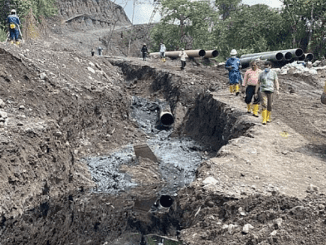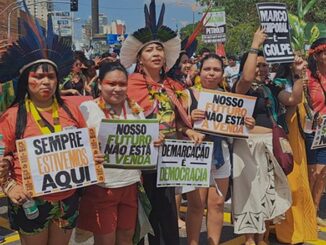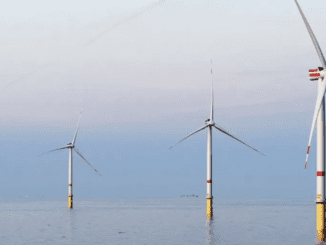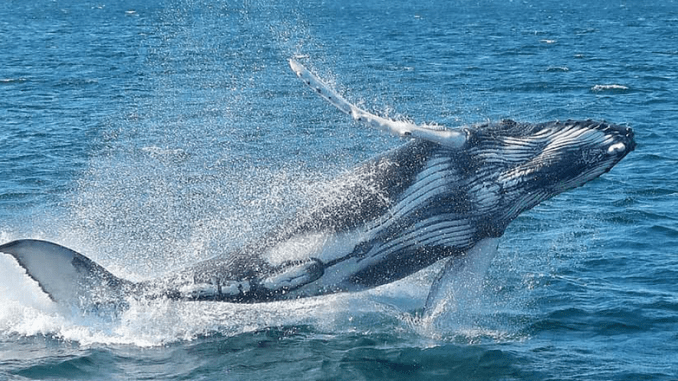
GLASGOW, Scotland, November 5, 2021 (ENS) – Ecuadorian President Guillermo Lasso has just expanded the marine reserve around the Galapagos Islands by 45 percent and created a protected swimway from Galapagos to Costa Rica. President Lasso announced the expansion at the COP26 climate summit in Glasgow, making the Galapagos Marine Reserve the largest oceanic reserve in any developing country.
The newly protected area covers 23,000 square miles, and the total size of the Galapagos marine protected area now extends over 74,000 square miles of ocean, inhabited by corals, sharks, penguins and marine mammals. The main threats here are the introduction of invasive species, increased tourism, population growth, illegal fishing and governance issues.
“Once more, Ecuador is a pioneering force in environmental protection both in Latin America and worldwide,” President Lasso said. “Today is a day that will remain in history for us, Ecuador, Galapagos and the world. We are not only preserving the future of our country but the entire humanity.”
The expansion is linked to Ecuador’s target of reaching protection of 30 percent of its marine territory by 2030, as the world is on the brink of a new treaty to protect the planet negotiated during the UN Conference on Biological Diversity in October.
Galápagos-Cocos Swimway Created to Protect Migrant Species
Ecuador’s declaration creates an essential migratory corridor that bridges the gap between the protected waters of the Galápagos Marine Reserve and Costa Rica’s Cocos Island National Park.
Ecuador’s Minister of Environment, Water and Ecological Transition Gustavo Manrique said, “This new marine reserve expands the current area by 60,000 new km2 and creates a corridor which connects Ecuadorian waters with Costa Rican waters, thus creating a safe swimway where important endangered migratory species, such as sharks, whales, turtles and manta rays travel.”
Located in the Pacific Ocean some 1,000 km (600 miles) from the South American continent, at the confluence of three ocean currents, the Galapagos volcanic islands and surrounding marine reserve have been given UNESCO World Heritage status and recognized as a unique living museum and showcase of evolution.
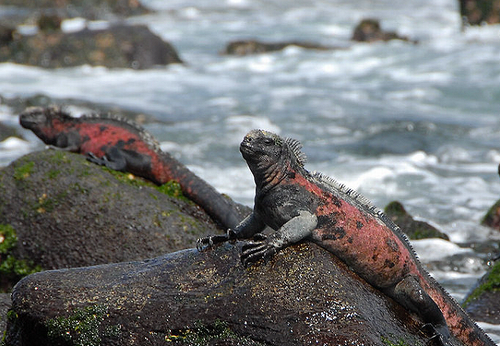
Ongoing seismic and volcanic activity formed the islands and, with their complete isolation, led to the development of unusual animal life such as the marine iguana, the giant tortoise and the many types of finch that inspired biologist Charles Darwin’s theory of evolution by natural selection following his visit in 1835.
Among those praising the move is Sarah Darwin, the great-great-granddaughter of Charles Darwin. A botanist and an ambassador for the Galapagos Conservation Trust, Sarah Darwin told the BBC that she was “very, very excited that President Lasso is taking the Galapagos so seriously.”
The new Galápagos-Cocos Swimway in the Eastern Pacific is an underwater superhighway for a host of threatened and endangered migratory species like Whale sharks, Scalloped hammerhead sharks, manta rays, sea turtles, tuna, and many more species that pass through the oceanic thoroughfare.
More than 10,000 scientists and global citizens have called for the Cocos-Galapagos Swimway to be a fully-protected zone.
By securing this biodiversity-rich space between the two marine UNESCO World Heritage Sites as a protected swimway, a major corridor of vulnerability for marine wildlife that has previously been a haven for industrial fishing, including shark finning fleets, has been eliminated.
The move earned President Lasso praise from ocean advocates such as the Galapagos Conservancy, a U.S. nonprofit based in Virginia.
The Galapagos Conservancy expects that populations of these threatened and endangered species will soon begin to rebound, and we hope that this agreement between Ecuador and Costa Rica will serve as a model for multinational collaboration in marine conservation going forward.

Galapagos Conservancy is committed to stepping up to ensure the protection of these newly established sanctuaries. The group will continue to provide financial support for the Galápagos National Park’s Galapgos Marine Reserve patrol boats, and are planning to award more grants that focus on marine conservation in 2022 than ever before.
The nonprofit Turtle Island Restoration Network, based in California, placed a full-page ad in the “New York Times” in September, calling on the presidents of Costa Rica and Ecuador to protect migratory marine species by creating the Cocos-Galapagos Swimway.
The ad, endorsed by oceanographer Dr. Sylvia Earle, founder of Mission Blue, and more than 150 organizations around the world, was also published in “La Nación” as both countries commit to protecting at least 30 percent of their marine territories by 2030.
“It’s important to think like the sharks, the sea turtles and the various forms of life that are not just found in places where we’ve named and claimed territory,” said Dr. Earle.
“We must consider the creatures that occupy this liquid space that we call the ocean and realize that if we were to take action to protect them, it’s not good enough that Cocos and Galapagos have an area of a safe haven around them. What about the space in between? That has to be protected too,” Dr. Earle said, explaining her underlying rationale.
Research completed by an international group of marine scientists known as MigraMar indicates endangered marine species including green sea turtles, leatherback sea turtles, and scalloped hammerhead sharks become vulnerable to fishing when they migrate between Costa Rica’s Cocos Island National Park and Ecuador’s Galapagos Marine Reserve
Ecuador’s Minister of Environment, Water and Ecological Transition Gustavo Manrique said, “This new marine reserve expands the current area in 60,000 new km2 and creates a corridor, which connects Ecuadorian waters with Costa Rican waters, thus creating a safe swimway where important endangered migratory species, such as sharks, whales, turtles and manta rays travel.”
He said this newly expanded marine reserve will serve as a living laboratory to conduct scientific research for a deeper understanding of the biosphere.
Featured image: Humpback whale in the Galapagos Marine Reserve. undated (Photo courtesy Rainforest Cruises)

